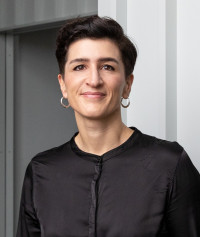Inclusion through design - how inclusive design succeeds
by Birgit Maier
Inclusive design helps companies expand their customer base, boost innovation and create accessible products. Sounds great, but how does it work?
"What am I really looking forward to? To the day when Siri, Alex[a] and co can understand more than one way of speaking. That will be my paradise." The author and blogger Tanja Kollodzieyski lives with a motor disability. She experiences moments of exclusion in her everyday life again and again.
Inclusive design aims to think about and address such barriers in the creation of products and services. And this is an important approach not only for people with disabilities. Let's face it: we've probably all experienced speech systems that don't understand us. Automated customer hotlines can leave us frantic with the phrase, "I'm sorry, I didn't understand you." Sometimes it's because of us - if we speak slurred, softly or with a strong dialect. Sometimes it's due to background noise or the connection.
Inclusive design aims to provide an equally good user experience for all users in all usage situations. In order for this to succeed, some basic rules must be followed.
Inclusive design = accessible products?
Accessibility and inclusion are often used synonymously in everyday life, but they are not the same thing. Inclusive design ensures a comparable user experience of products and services for all people. And it does so regardless of individual prerequisites and usage situations.
Accessibility, on the other hand, enables unhindered access to services and the use of products. It is therefore an important component of inclusive design processes. Ideally, they are intertwined. A digital service is inclusive if, for example, I am not forced into binary pigeonholes (male/female) when registering. The service is accessible if I can use different input and output means (language, keyboard) to use the service.
Wanted: diverse teams
Inclusive design has many benefits for all of us. So why is it not yet the norm to work inclusively in product development?
Because it requires a change in the general approach and way of working in companies. Inclusion and accessibility are very difficult to apply to finished products later on. Inclusive approaches and requirements must already be taken into account in the development and planning phase of products and services.
But how can inclusion be considered in design and development processes? Many companies offer diversity training to their employees. These can help raise awareness of exclusion and help train inclusive thinking. However, they are not the sole solution to such a complex and profound issue.
Exclusion often happens subconsciously and unintentionally. To think about inclusive solutions in design processes as comprehensively as possible, diversity is needed in all areas of the product development process. Product teams need to be diverse. Greater diversity is needed in the recruitment of test subjects for product tests and also among decision-makers in the company. Inclusive design can only be successful if inclusion is taken seriously from the outset and considered at all stages of the process.
Inclusive design concerns us all
In inclusive design, we think in terms of usage situations instead of usage types. During development, the question is not what the product can do for a specific group of users, but what task it must fulfill in a specific situation.
Inclusive design is not just for the inclusion of individual groups of people who are permanently limited in some way. We can all benefit through temporary or situational limitations - be they short or medium term. Imagine you're caring for a sleeping child and want to watch a video or movie on the side, but you don't have headphones within reach: thankfully, there are subtitles.
Development teams are tasked with using inclusive design to proactively look for excluding situations and screen their products for any weaknesses. To do this, exceptional use scenarios and associated product requirements must be researched and thought about.
Inclusion must be seen for what it is: not an optional extra, but a necessity.
Inclusion fuels innovation - innovation creates competitive advantage.
Our society is complex and diverse. This reality must also be reflected in the design of products and services. Many companies are thus faced with a major task with a corresponding investment of time and energy. At the same time, the advantages of inclusive design should not be underestimated. The decisive keyword is: innovation.
The innovative power of a company can be massively increased by diverse teams focusing on inclusive design. This results in accessible products and services that still offer differentiation potential. And even more: the innovative solutions and products automatically expand a company's customer base.
The calls for diversity and inclusion in all areas of life are getting louder and louder. Inclusive design concerns us all and helps us all. But it takes a clear commitment and unwavering purpose on the part of companies to make inclusive design the standard. Because: diversity is a fact, inclusion is a choice.
We are happy to receive project inquiries
Jana Kamm,
Senior Managerin Corporate Communications



